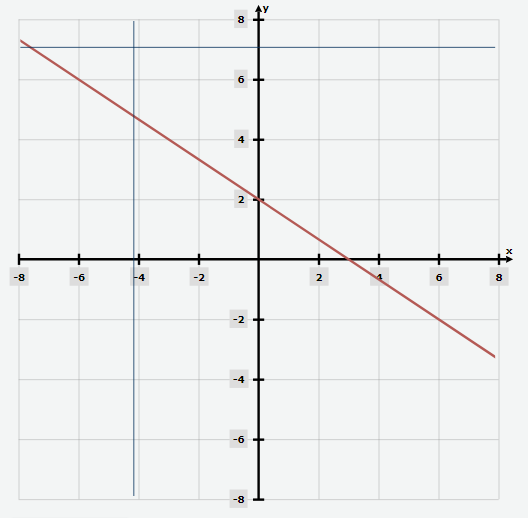How to Graph an Equation in the Standard Form?
Graphing an equation in standard form involves plotting the equation on a coordinate plane, where the \(x\) and \(y\)-axes represent the horizontal and vertical dimensions, respectively. The standard form of an equation is \(Ax + By = C\), where \(A, B,\) and \(C\) are constants.

A step-by-step Guide to Graph an Equation in the Standard Form
Here are the steps to graph an equation in standard form:
Step 1: Find the \(x\) and \(y\)-intercepts
The \(x\)-intercept is the point where the equation intersects the \(x\)-axis, and the \(y\)-intercept is the point where the equation intersects the \(y\)-axis. To find the \(x\)-intercept, set \(y = 0\) in the equation and solve for \(x\). To find the \(y\)-intercept, set \(x = 0\) in the equation and solve for \(y\).
Step 2: Plot the intercepts
Mark the \(x\)-intercept on the \(x\)-axis and the \(y\)-intercept on the \(y\)-axis. These two points will help you sketch the line.
Step 3: Determine the slope
The slope of the line is the ratio of the change in \(y\) to the change in \(x\). Rearrange the equation in slope-intercept form \((y = mx + b)\), where \(m\) is the slope and \(b\) is the \(y\)-intercept. To find the slope, divide the coefficient of \(x\) by the coefficient of \(y\), and simplify if possible.
Step 4: Plot additional points
To sketch the line, you need at least one additional point. Choose any value of \(x\), plug it into the equation, and solve for \(y\). This will give you the coordinates of another point on the line. Plot this point on the coordinate plane.
Step 5: Sketch the line
Use a straight edge or ruler to draw a line through the intercepts and the additional point. This line represents the graph of the equation.
Graph an Equation in the Standard Form – Examples 1
Graph the equation \(2x + 3y = 6\)
Solution:
Step 1: Find the intercepts.
To find the \(x\)-intercept, set \(y = 0: 2x + 3(0) = 6\), so \(x = 3\). The \(x\)-intercept is \((3,0)\).
To find the \(y\)-intercept, set \(x = 0: 2(0) + 3y = 6\), so \(y = 2\). The \(y\)-intercept is (0,2).
Step 2: Plot the intercepts.
Mark the \(x\)-intercept \((3,0)\) on the \(x\)-axis and the \(y\)-intercept \((0,2)\) on the \(y\)-axis.
Step 3: Determine the slope.
Rearrange the equation in slope-intercept form: \(3y = -2x + 6\), so \(y = (-\frac{2}{3})x + 2\). The slope is \(-\frac{2}{3}\).
Step 4: Plot additional points.
Choose any value of \(x\), such as \(x =9\), and solve for \(y: 2(9) + 3y = 6\), so \(y = 0\). Point \((9,-4)\) is on the line.
Step 5: Sketch the line.
Use a straight edge or ruler to draw a line through the intercepts and the additional point. The line represents the graph of the equation.
The graph of the equation \(2x + 3y = 6\) is a straight line passing through the points \((3,0)\) and \((0,2)\).

Exercises for Graph an Equation in the Standard Form
Graph each equation.
- \(\color{blue}{4x+2y=8}\)

- \(\color{blue}{3x+5y=15}\)


- \(\color{blue}{4x+2y=8}\)

- \(\color{blue}{3x+5y=15}\)

Related to This Article
More math articles
- Math Courses Required For A Business Degree
- 8th Grade MAAP Math Worksheets: FREE & Printable
- How long Is the SHSAT Test?
- 3rd Grade New York State Assessments Math Worksheets: FREE & Printable
- 8th Grade North Carolina End-of-Grade Math Worksheets: FREE & Printable
- How to Apply Limit Properties
- 4th Grade MEA Math Worksheets: FREE & Printable
- 4th Grade PARCC Math FREE Sample Practice Questions
- Why Learning Styles are a Myth?
- CLEP College Algebra Formulas




















What people say about "How to Graph an Equation in the Standard Form? - Effortless Math: We Help Students Learn to LOVE Mathematics"?
No one replied yet.